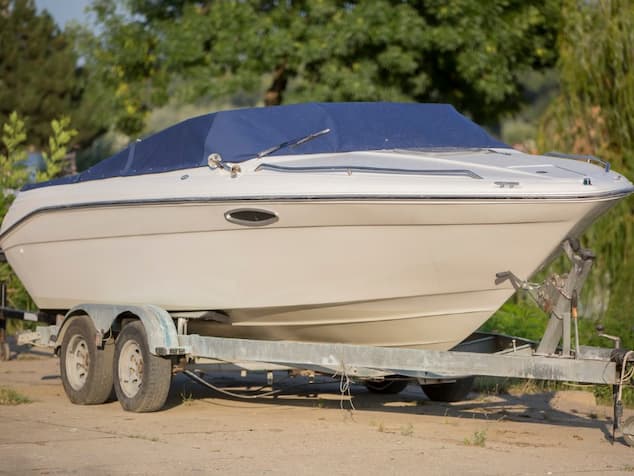Contents
Few things in life bring as much serenity and bliss as taking your boat out on the water. The soothing sound of waves lapping against your hull, the sun shining down upon you, and the joy of being surrounded by nature – it’s unlike anything else.
But as much as we’d like to, we can’t be out on the water all the time. And when our vessels are idle, they need adequate protection from the elements. This is by far the most crucial step in taking care of your boat since being exposed to harsh weather can cause serious damage. Your best bet is to invest in a durable and resilient boat cover and use it for every season.
What Are Boat Covers Made From?

The way a certain material will perform as a cover for a boat comes down to its water-resistant qualities and overall longevity. Some options have greater flexibility, while others provide more protection from the sun.
Polyester
This fabric is woven with strong fibres and provides excellent UV protection thanks to its colourfastness. In addition, it’s mildew, rot and abrasion-resistant, making for a boat cover that offers superior protection from the elements. Its inherent flexibility also allows it to fit snugly around your boat, which is great for preventing water seepage.
Acrylic
This man-made fibre has a soft, wool-like texture and is very durable. It’s able to retain its shape reasonably well over time, providing a secure fit around your boat. It also has excellent UV protection and is quite resistant to mould and mildew, often treated with a water-resistant coating.
Nylon Blends
Nylon is renowned for its strength and longevity, mainly because it’s a lot less prone to wear and tear than other fabrics. It also has good abrasion resistance, so there’s minimal risk of tearing. Unlike polyester covers for boat however, those made from nylon aren’t colourfast and should be treated with a water-resistant coating for maximum protection.
Generally speaking, the heavier the material, the greater protection it offers. Polyester and nylon blends are usually a safe bet as they’re both lightweight and sturdy, but ultimately, acrylic might be the safest option for maximising protection from fluctuating weather conditions.
Major Factors to Consider

Aside from the material, there are a few other important factors to consider when choosing your boat cover. Some of these are often overlooked, but being mindful of them can make all the difference in preserving the condition of your vessel.
Size and Fit
In terms of fit, you can go in one of three ways: custom, styled-to-fit or flex-fit. Custom covers are tailored to your specific boat model and size, providing superior protection as they fit snugly around its contours. When producing them, manufacturers take into account the vessel’s height, width, length and shape for a truly form-fitting design.
Styled-to-fit models are commonly referred to as a semi-custom fit because they are designed for a specific make and model but not to its exact dimensions. These are often made with a drawcord, allowing you to adjust the tightness and overall shape.
Finally, flex-fit varieties can suit multiple boat models and sizes within a certain range. They’re usually made from a stretchable material to allow for a more adjustable fit, but since they don’t hug the shape of your hull as well as the other two, their waterproofing abilities may be compromised.
Breathability
Keeping your boat’s interior well-ventilated is key to your overall health, mainly because high humidity levels can cause mould and mildew to form. This is why breathable fabrics are critical when it comes to covering it during storage or in between outings. Without proper ventilation, the air inside can become stagnant and result in unbearable odours.
In most cases, polyester and acrylic coverings provide good breathability due to their woven construction and often have additional vent flaps so that air can circulate. Nylon is somewhat breathable, but if you’re intent on using a nylon blend for your cover, make sure to add air vents to enhance circulation. You should check the product description for breathability ratings before making a purchase.
Cleaning and Maintenance
Regularly cleaning and maintaining your cover is a fundamental step in ensuring its longevity. The best way to go about this is to follow the specific instructions provided by the manufacturer. In most cases, it involves hosing down the cover, scrubbing it with mild soap and a brush, and then allowing it to air dry.
How Do You Put a Cover on Your Boat?

Once you’ve decided on the make and model that best suits your needs, you’ll need to know how to properly apply the cover. The process may vary depending on the type of model you have, but in general, you should start by laying the cover on the deck and fitting it over each side of the hull.
Next, secure the front and back of your vessel by wrapping the cover tie-down straps, loops or webbing around the cleats. Make sure these are tight and secure before moving on to the following step. Once everything is in place, using the elastic cord sewn into the hem of the cover, pull it snug around your boat’s contours and tie it off. Now you can rest assured that it’ll be kept in pristine condition until the next time you want to catch some waves.



Comments are closed.